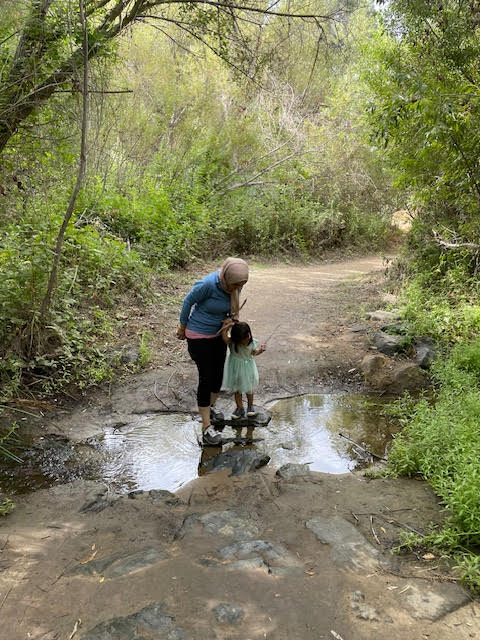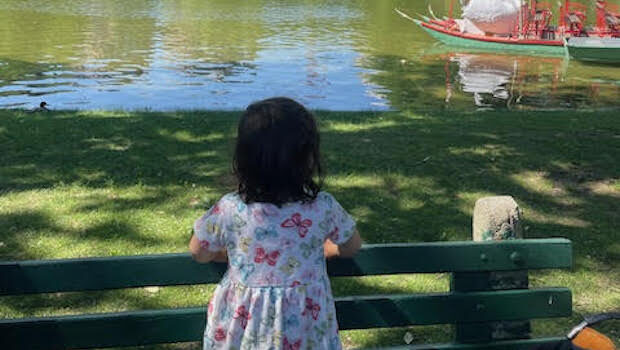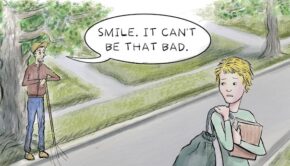Gaza in My Daydreams
I have always been a daydreamer.
As a child, I would act out my daydreams in our living room. Amid red-navy Persian rugs and bowls of pesteh (pistachios), I would metamorphose into Robin Hood, a pint-sized champion for the common person. I have a vivid memory of drawing up an imaginary pail of water and distributing it to imaginary people who were thirsty. In those moments, I was a hero.
I now wonder if this elaborate dream-acting was my young mind grappling with the discovery of water barrels in a storage room in our home. I was born in the aftermath of the Iran-Iraq war, to parents who had fled Iraq under Saddam Hussein’s dictatorship. Hoarding for a bad day—when food or water may not be available—was a survival strategy. But there must have been a part of my young mind upset and afraid of the possibility that water could ever run out.
Luckily, it never did. At least not for us. I drank clean water, savored pesteh, and basked in the afterglow of my self- and hero-centered daydreams.

As I grew older, the landscape of my daydreams shifted as we immigrated to Canada and then the United States. But I still used my daydreaming to imagine alternative, happier endings to daily experiences that left me embarrassed or wanting. I imagined myself as an Olympic ice skater after falling too many times on a middle school ice-skating field trip. I daydreamed winning a Pulitzer Prize after receiving critical edits on a writing assignment in high school. I daydreamed my high school, college, and medical school graduations. When those daydreams turned into realities, I daydreamed the next anticipated milestone. I daydreamed my engagement, my wedding, having children. My daydreams were happy and uplifting, centering me as a formidable protagonist. My daydreams buoyed me.
But daydreams can become maladaptive, taking over rather than providing respite. This maladaptive daydreaming, I have read and been told by my therapist, can be a response to depression, anxiety, or trauma. After I had a miscarriage, for example, my daydreams were frequently of my miscarried fetus-turned-child. I would see a child, smiling and sticky in a stroller, and my mind would daydream a world with my would-be child. I daydreamed of scraped knees and spilled applesauce. I lamented that these daydreams were not my reality. Then, when I tried to daydream becoming pregnant again, I would turn to imaginations of these pregnancies turning into more miscarriages. My daydreams became expansive, yearning for life, and for more cognitive real estate.
Until the passage of grief, guided by therapy, ushered me back into the realm of uplifting daydreams. I learned that I had to actively practice steering the narrative of my daydreams toward hope if I wanted any respite from my despair and melancholy.
With each passing day of Israel’s military aggression in Gaza, now determined by the International Criminal Justice as plausible genocide, my daydreams have once again taken a somber turn. My daydreams were, and continue to be, transformed daily into haunting nightmares.

When my toddler had a diaper rash, and she screamed with each diaper change because her skin was raw, I cried imagining her face and neck charred black with fourth degree burns with no access to pain medications or antibiotics. When my preschooler walked on a balance beam in gymnastics class, I cried imagining her with amputated legs and arms, the image of missing, bandaged limbs of children too young to walk seared into my brain. When my kids carry their backpacks with food and water bottles, I imagine carrying their bloodied backpacks and bodies. Or their bodies in backpacks. Or backpacks with no bodies to carry them. I find myself grappling with the stark contrast between my reality and the reality endured by children and parents in Gaza. I wonder if other mothers are having daydreams-turned-nightmares like me.
And it has not been easy to forge alternative endings to these daydreams-turned-nightmares. I have struggled to will my mind to envision a world where my daughters and the children of Gaza, alike, revel in the simplicity of birthdays and warm bread. But I push myself to imagine these alternative endings anyway because I refuse to succumb to despair. I recognize this moment as one that necessitates moral clarity and consistent action in the service of my vision for a just world.
So, I continue to daydream. I daydream for myself and for the world. I dream of children eating orange slices and harvesting olives. I dream of muscles rebuilding around emaciated skeletal frames. I dream of prosthetic limbs and Paralympian champions. I dream of my children and the children of Gaza alike growing up to be adults. I repeat mantras and quotes, frenetic, desperate, whirling: “Out of the mountain of despair, a stone of hope.” “The future belongs to those who believe in the beauty of their dreams.” I fold these dreams like delicate origami.
Sometimes, I even daydream with my children.

The other day, after my preschooler had seen me fight back tears and heard me explain that I was crying for the children of Palestine, she walked away, dumped out building blocks, and built a large building.
“Look Mama!” she said after a few minutes, “I am building a house big enough for all the children in Palestine!”
I lowered myself to the sacred ground next to her, and we talked about the houses she would rebuild, how many rooms they would have, and the games she would play. For the future of our shared humanity, I build with her a home of dreams.





